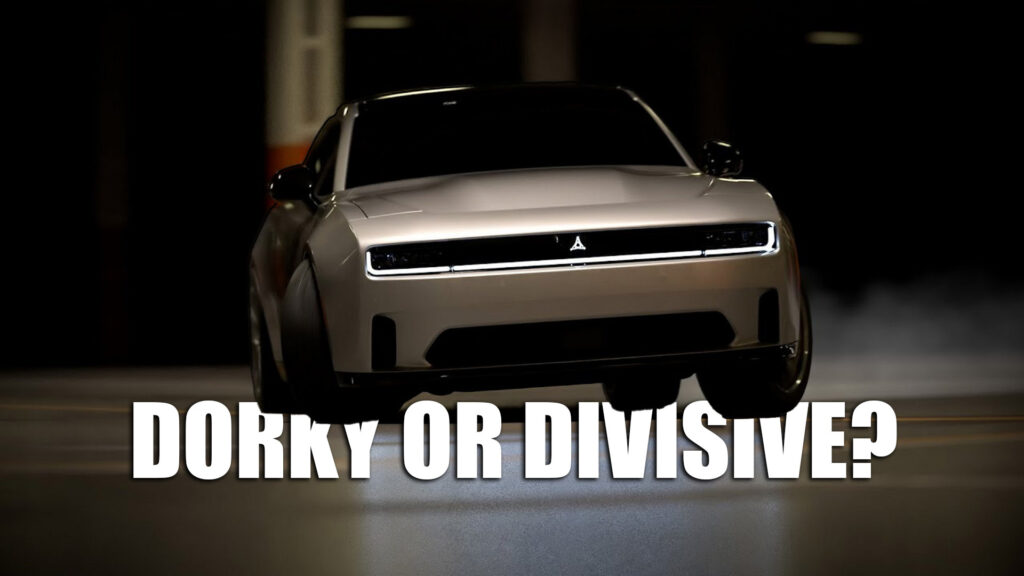This ad might cut out half of the buying population or it might just be a terribly acted cheesy attempt at convincing old-school muscle fans to go electric
March 6, 2024 at 13:29
 –>
–> 
–>
The all-new Dodge Chargers are finally here, bringing with them a slew of interesting facts and figures. But that’s not what’s ruffling feathers. Dodge also released a 10-minute commercial that is unquestionably dorky, but it’s also proving a bit divisive. Here’s a rundown of what the automaker came up with and why some are unhappy with it.
It’s no secret that Dodge has a lot riding on the new Chargers. The outgoing Challenger and Charger date in many ways back to 2005. The next-gen version ditches the HEMI V8, the old chassis, and just about everything aside from the name itself. It’ll come in all-electric form and will also be available with a twin-turbo inline-six. The transition is one that Dodge decided was worthy of a trip back in time.
That’s where this commercial begins, with CEO Tim Kuniskis literally going back in time to kidnap the Dodge Brothers themselves. He spouts exposition all over both of them as he explains how Dodge decided to build this new Charger, how it works, and how their influence played a large role.
advertisement scroll to continue
More: Dodge Charger Daytona Is Longer Than BMW X7, Heavier Than Cadillac Escalade ESV!
[embedded content]
The CGI is particularly cringe-worthy, silly, and almost seems AI-generated. Kuniskis appears to drift the new Charger in a parking garage (unquestionably on-brand) and then pilot it on an oval racetrack. What really has some up in arms though is his use of an us-versus-them theme while talking to the Dodge brothers.
Kuniskis talks about how the Charger breaks from convention and bucks the trend of most major EVs that focus so heavily on aerodynamics and range. Instead, he says that Dodge focused on building a muscle car worthy of the brand. Efficiency was never the point he says, “the point was they told us we couldn’t sell HEMIs but they never told us that we had to be boring and slow.”
To a degree that first point is dead on. HEMI V8s aren’t wildly efficient, and in fact, they were part of the reason that Dodge bought up carbon credits for so many years. Now that Stellantis has quit writing a blank check for those, Dodge has indeed been forced to get with the times. Somehow, despite that, it’s claiming that it left efficiency on the table to build a more muscular and more engaging car. If that’s true I can’t imagine a single performance car enthusiast who takes issue with it.

However, our colleagues over at Jalopnik took serious issue with the ad saying that it appeals to the “Republican victim complex.” Whether or not that’s true isn’t for me to say, but the piece might be missing the whole point.
Isn’t the intention of automobile ads to sell cars? Let’s face it, cars are political no matter how we slice it. Politics decides automotive regulation around the world. It influences what cars get made, how many of them are made, and what technology is baked into them.
Dodge, for better or for worse, has long eschewed convention and managed to be successful in the process. During its last year on sale, the long-in-the-tooth Challenger lost to the brand-new Ford Mustang in total sales by less than 4,000 units.
The Challenger beat both the Mustang and the Camaro the year before. If it takes a dorky Dodge commercial to sell ‘Uncle Randy’ on EVs enough that he actually buys one… does it really matter how he was converted to the all-electric side of things?
Perhaps the better question is if this ad will work despite the us-verses-the-establishment themes. Hardcore muscle car fans might not be convinced and hardcore electric vehicle enthusiasts and eco-focused folks might not love it either. What’s unquestionable is that Dodge bet big on going against the flow, as it has for a long while, and it did it with one of the dorkiest commercials we’ve seen in a while.


